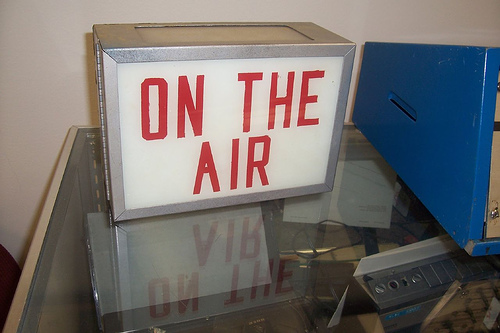


A program in Longmont, Colorado, is training people with disabilities to conduct interviews for radio broadcast as a way to overcome barriers in communicating. Last week, Longmont Times-Call reporter Magdalena Wegrzynand videographer Cliff Grassmick visited the studios of KGNU, an independent radio station in Boulder that broadcasts the segments, to see the program in action.
It’s hard to imagine Jessica Ratner ever being shy about approaching people for an interview. At the time of the story, the 34-year old program participant was wrapping up a piece where she conducted man-on-the-street interviews about the Penn State child sexual abuse scandal involving its football coaches — hardly an easy topic to just approach random strangers about and elicit meaningful responses.
Then, in Grassmick’s video, we see her cracking up her instructors during a discussion about a segment they just finished producing. She talks about where her own inhibitions come from around the 1:43 mark:
I don’t get afraid. I just get nervous because I’m talking to people I don’t really know, and I was told not to talk to strangers… And always when I go interview, I start laughing and get embarrassed and then my voice starts pitching up.
Program participants are involved in every aspect of producing the segments that are aired, from brainstorming story ideas to generating the interview questions. They receive training in the operation of a portable recorder to capture the audio from interview subjects and even work with audio-editing software.
But, as a spokesperson for the program points out, the participants develop their capacity for critical thought, working together as a group, and interacting within the community in addition to the hands-on manual skills.
Of course, effective communication is not a one-way street; talking to people with disabilities is of equal importance. We spent last Friday looking at several companies in Florida that are overcoming the perception that communication in the workplace between people with disabilities and other employees could be a barrier. In the case of Eric Thomas, we even saw how providing the adequate support and preparation at the onset of a job situation eventually led to an employee with a disability going about his tasks without needing a job coach on the premises any longer.
One of Diversity World’s “10 Commandments of Communicating With People With Disabilities” provides the following advice that sounds undoubtedly like one of the golden rules of journalism that Ratner and her fellow broadcast classmates are taught:
Listen attentively when talking with people who have difficulty speaking and wait for them to finish. If necessary, ask short questions that require short answers, or a nod of the head. Never pretend to understand; instead repeat what you have understood and allow the person to respond.
May we all keep listening and learning from each other.
Comments?
Image by Rochelle Hartmann, used under its Creative Commons license.